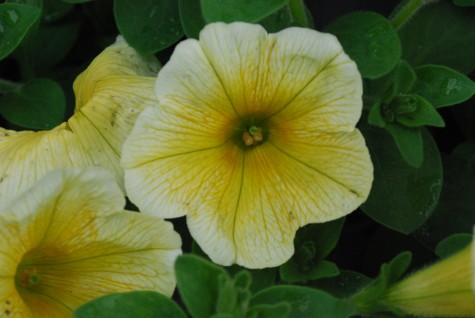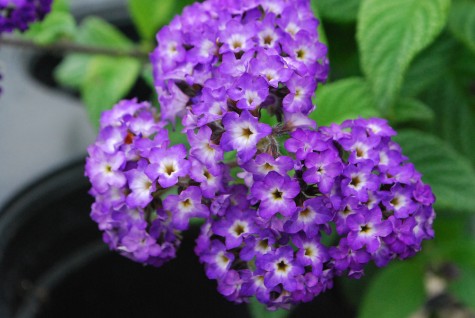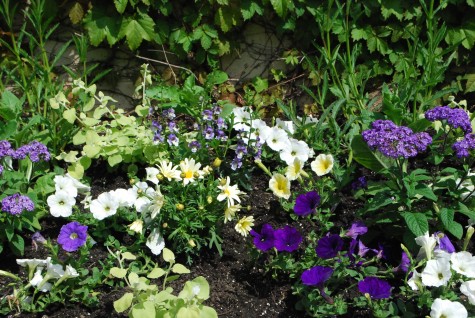 This is the time of year I start planting annual plants for clients. I am hoping we are at the tail end of the third rainiest spring on record; I planted all week last week in the cold rain. It is a good thing I really like to do this; it kept my mind off my wet feet. I have other things to think about besides being wet-like a color scheme, for instance. I just planted one small garden at the shop, in illustration of the idea of scheming. Scheming can refer to some underhanded activity-I prefer to think of it as an orderly way of working, or a way of working where all the pieces fit together in a satisfying way. The concept of a color scheme for a garden is easy to understand. Putting plants together where all of the respective colors workwell together-not always so easy.
This is the time of year I start planting annual plants for clients. I am hoping we are at the tail end of the third rainiest spring on record; I planted all week last week in the cold rain. It is a good thing I really like to do this; it kept my mind off my wet feet. I have other things to think about besides being wet-like a color scheme, for instance. I just planted one small garden at the shop, in illustration of the idea of scheming. Scheming can refer to some underhanded activity-I prefer to think of it as an orderly way of working, or a way of working where all the pieces fit together in a satisfying way. The concept of a color scheme for a garden is easy to understand. Putting plants together where all of the respective colors workwell together-not always so easy.
 Color schemes that feature contrast will be lively. The wild card of course is that every flower comes with a plant that has leaf color. The heliotrope pictured above has intensely purple flowers. The leaf color is a medium green. Flower color may be your primary interest-but there is a green scheme that needs attention too. The lime licorice in this pot is a green that contrasts well with both the flowers and the leaves of heliotrope.
Color schemes that feature contrast will be lively. The wild card of course is that every flower comes with a plant that has leaf color. The heliotrope pictured above has intensely purple flowers. The leaf color is a medium green. Flower color may be your primary interest-but there is a green scheme that needs attention too. The lime licorice in this pot is a green that contrasts well with both the flowers and the leaves of heliotrope.
 Both the lime and variegated licorice are invaluable in planning a color scheme. This lime green will read yellow, when planted next to yellow flowers. It will read very lime green when paired with red flowers. Red geraniums and lime licorice is a color combination that reinvents the red geranium.
Both the lime and variegated licorice are invaluable in planning a color scheme. This lime green will read yellow, when planted next to yellow flowers. It will read very lime green when paired with red flowers. Red geraniums and lime licorice is a color combination that reinvents the red geranium.
 This lantana topiary has several shades of yellow in the flowers. Both lemon yellow and deep yellow are represented. Why did I choose variegated licorice in this pot? That more blue green leaf relates better to the deep bluey-green of the lantana foliage. The alyssum chosen here is called “citron”. In a composition featuring yellow, it reads cream yellow. All of the greens featured here are related. All of the yellows relate.
This lantana topiary has several shades of yellow in the flowers. Both lemon yellow and deep yellow are represented. Why did I choose variegated licorice in this pot? That more blue green leaf relates better to the deep bluey-green of the lantana foliage. The alyssum chosen here is called “citron”. In a composition featuring yellow, it reads cream yellow. All of the greens featured here are related. All of the yellows relate.
 The third element in the lantana pot is a yellow potunia. Potunias are a series of petunias developed for a compact habit of growth, making them perfect for a container planting that does not necessarily ask for a trailing element. The lantana pot has a piecrust rim and band at the top-I would not want to completely cover that interesting detail. The pot is not that large-I would not want it to be overwhelmed by the planting. But the best part are the two tone yellow flowers-a perfect element for a yellow and green scheme so strongly suggested by the lantana standard.
The third element in the lantana pot is a yellow potunia. Potunias are a series of petunias developed for a compact habit of growth, making them perfect for a container planting that does not necessarily ask for a trailing element. The lantana pot has a piecrust rim and band at the top-I would not want to completely cover that interesting detail. The pot is not that large-I would not want it to be overwhelmed by the planting. But the best part are the two tone yellow flowers-a perfect element for a yellow and green scheme so strongly suggested by the lantana standard.
 Persian Queen geraniums have brilliantly lime green leaves; I value this about them more than their hot pink flowers. The lavender trailing verbena is a cool and striking foil for both the Geranium, and the scotch moss (sagina subulata aurea). Purple and lime green is a great place to start scheming.
Persian Queen geraniums have brilliantly lime green leaves; I value this about them more than their hot pink flowers. The lavender trailing verbena is a cool and striking foil for both the Geranium, and the scotch moss (sagina subulata aurea). Purple and lime green is a great place to start scheming.
 Variations on a color create visual interest. Heliotrope can vary from deep dark purple, to lavender. Sky Blue petunias are a very pale version of Royal Velvet petunias. Yellow petunias with Sky Blue and Royal Velvet petunias- a color scheme begins to tune up. Add some white petunias for bright, and some lime licorice to the green scheme makes for a series of color relationships that create visual interest.
Variations on a color create visual interest. Heliotrope can vary from deep dark purple, to lavender. Sky Blue petunias are a very pale version of Royal Velvet petunias. Yellow petunias with Sky Blue and Royal Velvet petunias- a color scheme begins to tune up. Add some white petunias for bright, and some lime licorice to the green scheme makes for a series of color relationships that create visual interest.

The scheme for this small anuual garden is as follows. Lavender verbena bonariensis, lime and white nicotiana alata are my tall elements. Mixes of three plants mix more evenly overall than mixes of 2 plants. My mid level plant-bicolor angelonia-white and purple in the same flower. Vanilla Butterfly marguerite is the pale cream yellow verson of the intense lemon yellow “Butterfly”. Purple heliotrope and yellow potunias finish up that level. On the border, white, sky blue/lavender and dark purple putunias mixed with lime licorice. This color scheme-white/purple and lime, with a dash here and there of yellow. If you think you see petunias and licorice planted from back to front between my tall flowers, you are right. The big growing annuals take a long time to come on. I like a bed of flowers that engages my eye from the start as well as the finish. We’ll see if my scheming amounts to something good looking; I have my fingers crossed. All is in the hands of the plants, and how they grow, now.
Deborah,
I love that buttery chartreuse and soft purple complementary planting in the pot. Great choices. I still have most of my container plantings for clients yet to do — it has also been so rainy here it’s starting to get me down …
Ailsa
Dear Ailsa, I am in the same spot. Once the weather gets to 80 degrees, as in tomorrow, there will be plenty of calls. It is frustrating-but every year there is something going on that is less than ideal. I will say all the rain has made every tree and shrub look luscious. My Princeton gold maples have leaves as big as dessert plates- oo la la. Deborah
Oh my goodness…the lavender trailing verbena against the gravel is so stunning!
What a great combo, that purple and lime green.
Thank you for teaching me!!
Dear Karen, I had not paid one bit of attention to how the color looked with the gravel. Ok, I am seeing this combination a little differently-thanks. Deborah
Hi Deborah,
I am struggling to find a globe shaped shrub ( max 3-4 ft tall ) similar looking to a boxwood or a globe little giant cedar that will withstand our windy cold zone 3.
Thank-you !
Marni
Dear Marni, I am over my head here-I am 2 zones warmer than you are. But there have to be a lot of places that you could get info-I just typed dwarf evergreens hardy in zone 3 into my computer search line- I found plenty to read. Maybe you could think of your landscape as a farm for ornamental plants-provide great drainage, and plant some windbreaks. The Canadian Explorer roses, and other groups of shrub roses are great in zone 3. Deborah
Greetings from Finland. I’m very impressed of your sites. It’s lovely to read about your projects.
Dear Tanja, many thanks for reading! Deborah
I just had to “tweet” about the container with the verbena and scotch moss. To me the moss puts it over the top and just makes it absolutely perfect.
thanks!